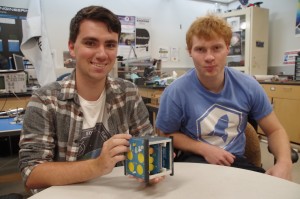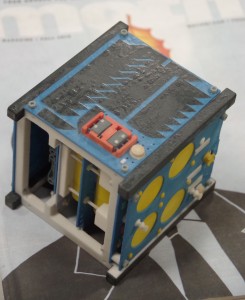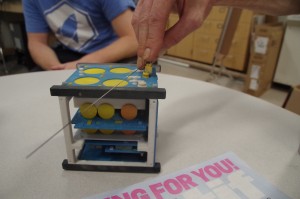
(Photo: Michael Bilow)
“The flashing is what we use to get people excited about” the satellite, designed and built by Brown University undergraduate students, that was launched into earth orbit from the International Space Station (ISS) in July, said Jacob Leiken, one of the project directors with Brown Space Engineering (BSE). “Our primary mission is to make space more accessible for people of all backgrounds.”
The main payload of the tiny 10cm cube is four extremely bright LEDs that can flash so brightly that the satellite, 400km above ground, should be visible to a ground observer’s naked eye, nearly as bright as Polaris, commonly known as the “North Star.” The satellite uses magnets to orient its LEDs toward the ground over the Northern Hemisphere, aligning itself with the natural magnetic field of the earth. “We don’t know of anyone who has” yet seen the satellite flashing from space, said Mckenna Cisler, another of the project directors.
When its experimental lithium-ferro-phosphate batteries are sufficiently charged by solar cells on the skin of the satellite, it will enter “flash mode” firing three bright flashes, each one-tenth of a second, during the first second of each minute. Circling the earth every 90 minutes or so, during a good pass over Providence the satellite would be visible for as long as 10 minutes as it appears to fly from horizon to horizon, and such good passes usually occur two or three times daily. Of course, the flashing would only be visible if the pass happens to occur in darkness against the night sky.

(Photo: Michael Bilow)
The satellite carries conventional radio equipment and can be received with fairly simple gear beaconing in the 70cm amateur (“ham”) radio band on 435.550MHz, according to Michael Umbricht, a faculty adviser to BSE who serves as curator of Brown’s Ladd Observatory. Umbricht, whose personal “ham” callsign is W9GYR, is trustee for the Brown Amateur Radio Club and its callsign K1AD as well as for the satellite and its special temporary authority experimental callsign WL9XZE. (Cisler, whose personal callsign is KC1ICW, is also active with the radio club.) Filing the legal paperwork for the satellite radio license rivaled the work of designing and launching the satellite, Umbricht joked, involving the International Telecommunications Union and the US Federal Communications Commission. “There was a lot of paperwork. We were working on paperwork right up to the deadline,” Leiken said.
“The last thing we had to do was prove the LEDs weren’t going to blind the astronauts,” Leiken said. The LEDs were configured not to light for three days after deployment, by which time the satellite would have drifted far away from the space station, but the team still had to prove that if something went wrong then it would not cause a problem. During the actual deployment, Leiken said, “an astronaut took a video from the cupola,” the crew space with windows to the outside, which BSE posted on Facebook. The LEDs flash with a brightness of tens of thousands of lumens, sufficiently bright that during testing it was necessary to wear solar goggles, Umbricht said; while an ordinary electronic flash on a small camera might be as bright, it is lit for only about 1/1,000 of a second, about 100 times shorter duration, and is therefore less blinding. Eventually, Cisler said, it was determined that it would be safe at the 18-meter distance separating the deployment mechanism from the cupola.
Public demonstrations of the radio ground station are planned. On September 22 during WaterFire, Cisler said, “There are… two decent passes at 7:08pm and 8:41pm… so we may try and demonstrate those if the event is still going on. We’re also planning on having BSE members present… even if they’re not working passes.” This is part of Brown’s Big Bang Science Fair, 3-10pm, at RISD Auditorium during WaterFire; free tickets are recommended in advance for the talks inside the auditorium but are not needed for the BSE demo. (See motifri.com/events/bbsf for details.)
Ladd Observatory is open weekly for public viewing every Tuesday, 8 – 10pm, when there is clear weather, and if that coincides with overhead passes then there may be efforts to communicate via the ground station. The satellite can be commanded by radio to flash its LEDs, Leiken said, so that may be attempted during public demonstrations.
Both Leiken and Cisler came into the project working on the software for the on-board computer, a total of about 300,000 lines of code, Leiken estimated, all of which have been published as open source on the web for use by other teams who want to replicate parts of the project. Bugs have arisen, and one bug prevents the satellite from entering “flash mode” as often as it should, Cisler said. “It’s a little embarrassing. It was a greater-than-or-equal-to sign that should have been a less-than-or-equal-to sign. In a certain state of our battery control system, it will be in low-power mode when the battery voltage is higher than a good value versus lower than a good value. We were pressed for time and things like that happen.” Cisler said he had to fly to Houston in person to update the software in the spring shortly before launch to fix another serious bug.
The project is now in its eighth year, Leiken said, and there has been a lot of turnover because undergraduates are typically around for only four years. BSE meetings regularly attract over 50 attendees, he said. Both Leiken and Cisler said that they got involved when, as first-year students, they attended an activity fair and saw a poster about BSE. This semester just started, Leiken said, but BSE has 44 new potential members in addition to between 20 and 30 returning members from last year although a lot of seniors were graduated. Leiken and Cisler are majoring in computer science, although Cisler said he intends to switch to engineering. Leiken said that his interest in space began with “Star Trek,” and his current focus in his field is on security and visual computing rather than embedded systems such as the satellite; he learned how to solder at BSE. Cisler said that the new members are not necessarily from conventional engineering backgrounds, and one is even a philosophy major. “It’s very fun for me and very different from what I do in my classes,” Leiken said.

(Photo: Michael Bilow)
BSE is planning for a second satellite, but new members do not begin working immediately on satellites. “A lot of our first-years and sophomores join the high-altitude balloon team. We’ve launched two and they have 360-degree cameras, and they were either the first or the second 360-degree cameras on high-altitude balloons, the highest 360-degree cameras ever, [reaching 80,000 feet]. We put on electronics kind of similar to what we have on the satellite, such as an altimeter – which is not on the satellite – but also gyroscope, magnetometer, accelerometer, temperature. Each balloon tests something that we want to test for the satellite. We’re currently working on a balloon that’s going to launch early this semester, because we did most of the work last semester, that has deployable solar panels,” Leiken said. EQUiSAT deploys its antenna using Nitinol “memory wire” – an alloy of nickel and titanium that returns back to its desired shape when heated – and the balloon uses a similar system to deploy its solar panels. “We were going to launch [the balloon] last semester but, because it’s a lot bigger,… it takes a lot more energy to burn those wires. We’re using an Arduino on the balloon whereas we use a custom Atmel chip in the board on the satellite, so we had trouble where burning the wire was burning out the electronics. That happened on the satellite, too, but not in a dangerous way… [Because antenna or solar panel deployment only happens once,] if the electronics [for heating the wire] are busted it doesn’t really matter… but there [on the balloon] they were burning up and would continue burning, a lot of smoke. We have to refine that a little bit,” Leiken said. The balloons are a good way for new team members to get involved in a short-cycle project, Cisler said, because “it doesn’t take seven years to launch.”
The satellite was carried on unmanned supply rocket OA-9 launched May 21, and then loaded by the astronauts aboard the ISS into the robotic arm mechanism that is designed to deploy standard “Cubesats” that are made up of individual 10cm “1U” cubes: That is, a 1U Cubesat (such as Brown’s) is 10cm x 10cm x 10cm, a 2U Cubesat is 20cm x 10cm x 10cm, and so on, and the robotic arm mechanism can hold up to 24U in a 4×6 grid. The deployment process consists of ejecting the Cubesats out into space at a velocity of about 1.5m/s, causing them to separate away from the ISS. The standardized form factor has proven extremely popular: as of August 11, the database recorded 875 Cubesats launched. There are companies that will make a Cubesat to order for organizations and businesses at a starting price of about $20,000 and sometimes substantially more, but Leiken said that the Brown team by doing almost all of the work in-house was able to produce theirs on a shoestring budget of only $3,700. Of the four satellites deployed at the same time on July 13, only two (including Brown’s) entered successful operation.
The design lifetime of the satellite is only about six months, according to Cisler, but after the electronics stop working it is expected to remain aloft for one to two years before decaying to burn up re-entering the atmosphere. Despite the software bug that affects flashing, Leiken said, they are still acquiring much data about the performance of the experimental lithium-ferro-phosphate batteries that power the flash, one of the main goals.
What was most surprising to them about the satellite project? Leiken answered, “That I could put so much time into something and still enjoy it. The semester before we launched, it took over both of our lives a lot, and we weren’t in leadership positions then. We both ran for leadership positions after having put in that much work.” Cisler answered, “That we can do this continues to blow me away. It’s just amazing that this thing is up there and working. We have amazing people in this club, but it always surprises me… Looking back we realize how much expertise we did have, but at the time it was, ‘Is this going to work?’” Leiken added, “We had a lot of people who spent four years working on it and really became experts by the time they were seniors. One of them was very pessimistic and gave us a 60% chance of failing and never hearing from it. I strongly disagreed with that, but that kind of attitude in a way helps because, if you have that attitude while you’re engineering something, you’re a lot more careful.”
BSE web page on how to view the satellite: brownspace.org/viewing-equisat; Tracking web page: equisat.brownspace.org; Facebook: fb.com/browncubesat; High-altitude ballon: youtube.com/watch?v=UVL7mOw5l5I 360-degree camera video: youtube.com/watch?v=67AHI_H-hzw; See where the satellite is and calculate when it will fly overhead: n2yo.com/satellite/?s=43552
Do your own celestial mechanics and calculate the satellite orbit based upon its Keplerian elements:
1 43552U 98067PA 18257.47658982 +.00011597 +00000-0 +17216-3 0 9994 2 43552 051.6389 293.1518 0006109 182.9456 177.1500 15.55678230009780
UPDATE: EQUiSAT de-orbited 26 Dec 2020 and is no longer aloft.


